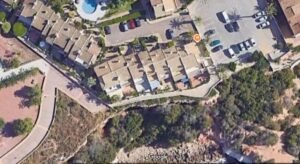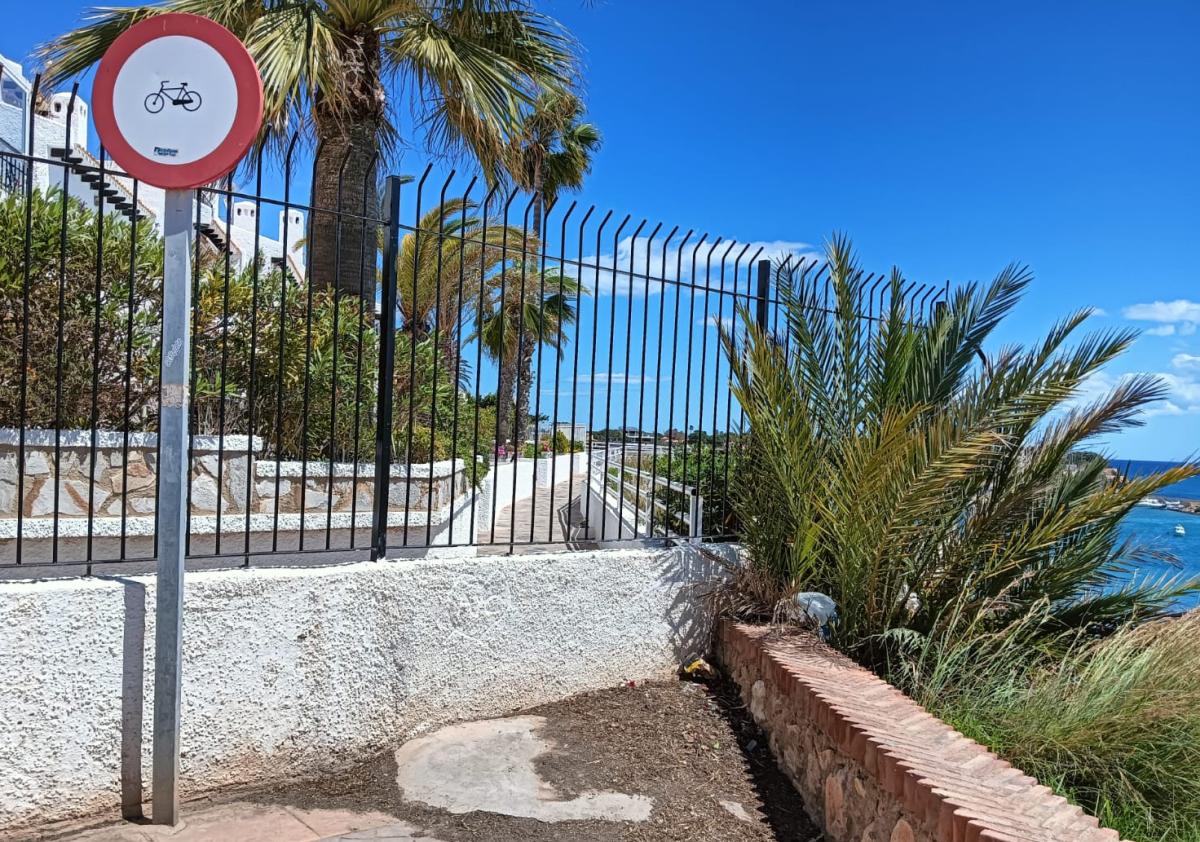Por Orihuela Costa Libre //
Recientemente, diversos medios de comunicación, se han hecho eco de lo que parece ser el final de la larga historia de encuentros y desencuentros entre los propietarios de la urbanización que cerraba el paso de la Caleta a Cabo Roig y el interés público, no siempre bien defendido por el Ayuntamiento de Orihuela.
Lo que podía haber sido una sangría para el erario publico municipal – el ayuntamiento tiene destinados 600.000 euros – ha quedado finalmente en un pago por expropiación de 26.180 euros conforme ha determinado el Jurado Provincial de Expropiaciones de Alicante. A esta cantidad habŕa que sumar unos 50.000 euros para ejecutar la obra de acondicionamiento del paseo.
Solo queda que el ayuntamiento deposite en el juzgado el importe justipreciado para que el ayuntamiento pueda romper los muros y las rejas para que los vecinos puedan recorrer los apenas 170 metros de costa que prolongan el paseo de Aguamarina hasta Cabo Roig.

Cronología de la lucha vecinal contada por sus protagonistas
La intrahistoria ,narrada por algunos de sus protagonistas, de un paso que nunca debió ser usurpado al uso publico es la historia de éxito de una larga, vieja y constante reivindicación vecinal. En todos estos años Unidos x la Costa, antes Asociación de Vecinos de Cabo Roig y Lomas (AVCRL),no ha dejado de preguntar, escribir e insistir sobre el expediente. Son 20 años de lucha vecinal que pueden culminar favorablemente en breve.
El inicio de la reivindicación de la apertura del paso tiene su origen en un grupo de vecinos de Aguamarina directamente afectados que no se conformaron con el bloqueo del paso de la costa en el Residencial Bellavista I, urbanización construida en 1985.
En el año 2005, vecinos de Calas de Campoamor en Cabo Roig se reunieron en Madrid con ejecutivos de la Dirección General del Mar (MITECO) para solicitarles la apertura del paseo . La reclamación se basaba en el bloqueo de una zona situada en zona de dominio público marítimo terrestre.
Fue entonces cuando varios de aquellos vecinos se entrevistaron con un reputado abogado urbanista de Murcia, ya fallecido, que, de forma totalmente altruista, asesoró sobre la forma y manera de reclamar la apertura del paseo. A raíz de la consulta, un vecino de Orihuela Costa presentó un escrito en la concejalía de Urbanismo y Patrimonio solicitando la apertura del paseo.
Acciones, inacciones, demoliciones y reconstrucciones al pairo de sentencias y decisiones incomprensibles del Ayuntamiento de Orihuela. Se abre en 2015.
En el año 2013, el entonces concejal socialista del equipo de gobierno, Antonio Zapata, inició un expediente de recuperación del dominio público y restablecimiento de la legalidad urbanística, al considerar que los muros de cierre se habían construido sin licencia. Esta acción, junto con la consulta y presión vecinal, culmino en un decreto de demolición emitido por el citado concejal, lo que permitió la apertura del paso en marzo de 2015.
En 2016 los vecinos de la urbanización Bellavista I donde se encuentra el paso en disputa recurrieron la apertura en la vía contencioso-administrativa. El recurso resultó favorable a sus interés, condenando el juzgado comarcal de Elche al ayuntamiento a abrir el paso. La sentencia se basaba en un error urbanístico – administrativo del ayuntamiento de Orihuela que no había iniciado ningún expediente de expropiación del suelo afectado.
El paso, después de seis años abierto, fue cerrado por el ayuntamiento en diciembre de 2021.
El ayuntamiento sumó otro error cuando el entonces equipo de gobierno popular no recurrió la sentencia, por lo que ésta se hizo firme. En el año 2017 el Servicio Provincial de Costas declaró que el paseo estaba afectado por una servidumbre de paso publico que no podía cerrarse.
Sin tener resuelta la expropiación, el ayuntamiento recurrió la ejecución de la sentencia llegando el caso hasta el Tribunal Supremo, que ordenó el cierre definitivo en el año 2021, otra vez en base a la inexistencia de una expropiación del terreno de dominio publico. Y así permanece desde entonces.
Tras la expropiación y el justiprecio se espera que el paso quede abierto antes de verano de 2025.
Por fin, el ayuntamiento de Orihuela asumió que el problema estaba en su falta de diligencia al no efectuar la expropiación aprobando el inicio de expediente en el pleno de diciembre de 2023. Tras dos años, y la sentencia de la Junta de Expropiaciones de Alicante se prevé abrir el paseo antes de este verano.
Para los protagonistas de la historia, la maquinaria municipal ha sido muy lenta lo que han provocado un retraso de más de 20 años en la solución definitiva caso. Y la apertura del paso para el disfrute publico un asunto conseguido gracias a la presión y constancia de los vecinos que ha culminado el actual equipo de gobierno.
En este largo proceso queda la duda sobre si los errores municipales en el procedimiento , al no recurrir la sentencia, y el error al recurrir la ejecución en lugar de iniciar el proceso de expropiación pertinente fue fruto de la ineficiencia o hubo algo más detrás de aquello.
También la certeza de que los errores no los pagará el responsable del desaguisado sino todos nosotros. Así como la sospecha de que en los cajones del ayuntamiento de Orihuela puede haber más errores como este en marcha; o si saltaran sorpresas quizá no tan favorables para un erario publico que es de todos.

The opening of the passage from La Caleta to Cabo Roig, a success of the neighbourhood claim
Recently, various media outlets have echoed what appears to be the end of the long history of meetings and disagreements between the owners of the urbanisation which closed the passage from La Caleta to Cabo Roig and the public interest, not always well defended by Orihuela Town Hall.
What could have been a drain on the municipal exchequer – the town hall has 600,000 euros earmarked for it – has finally resulted in an expropriation payment of 26,180 euros as determined by the Provincial Expropriation Jury of Alicante. To this amount there would have to be added some 50,000 euros to carry out the work of conditioning the promenade.
All that remains is for the town hall to deposit the amount in court so that the council can break down the walls and railings so that the residents can walk along the 170 metres of coastline that extend the Aguamarina promenade to Cabo Roig.
Chronology of the neighbourhood struggle told by its protagonists
The intrahistory narrated by some of its protagonists of a crossing that should never have been usurped from public use is the success story of a long, old and constant neighbourhood claim. In all these years Unidos x la Costa, formerly Asociación de Vecinos de Cabo Roig y Lomas (AVCRL), have stopped asking, writing and insisting on the file. 20 years of neighbourhood struggle that may soon end favourably.
The beginning of the demand for the opening of the crossing has its origin in a group of neighbours of Aguamarina directly affected who were not satisfied with the blockage of the coastal crossing through Residencial Bellavista I, a development built in 1985.
In 2005, residents of Calas de Campoamor in Cabo Roig met in Madrid with executives of the Directorate General of the Sea (MITECO) to request the opening of the promenade. They based their request on the blockage of an area located in the public maritime terrestrial domain.
It was then that several of those neighbours met with a reputed town planning lawyer from Murcia, now deceased, who, in a totally altruistic way, gave advice on the form and manner of claiming the opening of the promenade. As a result of the consultation, a resident of Orihuela Costa then presented a letter to the Councillor for Town Planning and Heritage requesting the opening of the promenade.
Actions, inactions, demolitions and reconstructions at the mercy of incomprehensible rulings and decisions by Orihuela Town Hall. It opens in 2015.
In 2013, the then socialist councillor of the government team, Antonio Zapata, initiated a file for recovery of the public domain and reestablishment of urban planning legality, considering that the enclosure walls had been built without a licence. This action, together with consultation and pressure from neighbours, culminated in a demolition decree issued by the aforementioned councillor, which allowed the opening of the crossing in March 2025.
In 2016, the residents of the Bellavista I housing estate, where the disputed crossing is located, appealed the opening of the crossing in the administrative courts. The appeal was favourable to their interests, and the Elche regional court condemned the town council to open the crossing. The judgement was based on an urban planning and administrative error by the Orihuela town council, which had not initiated any expropriation proceedings for the affected land.
The pass, after six years open, was closed by the town hall in December 2021.
The town hall added another error when the then popular government team did not appeal the judgement, so that it became final. In 2017 the Provincial Coastal Service declared that the promenade was affected by a public right of way that could not be closed.
Without having resolved the expropriation, the city council appealed the execution of the sentence and the case went all the way to the Supreme Court, which ordered the definitive closure in 2021, again on the grounds that there was no expropriation of the public domain land. And it has remained so ever since.
After the expropriation and the compensation, it is expected that the pass will be open before the summer of 2025.
Finally, the Orihuela Town Hall accepted that the problem lay in its lack of diligence in not carrying out the expropriation, approving the initiation of the process in the plenary session of December 2023. After two years, and the judgement of the Alicante Expropriation Board, the promenade is expected to open before this summer.
For the protagonists of the story, the municipal machinery has been very slow which has caused a delay of more than 20 years in the final solution. And the opening of the walkway for public enjoyment is a matter achieved thanks to the pressure and perseverance of the neighbours, which has culminated in the current government team.
In this long process, the question remains as to whether the municipal errors in the procedure, in not appealing the sentence, and the error in appealing the execution instead of initiating the relevant expropriation process was the result of inefficiency or whether there was something else behind it.
Also the certainty that the errors will not be paid for by the person responsible for the mess, but by all of us. As well as the suspicion that in the drawers of Orihuela Town Hall there may be more errors like this one in progress; or if there are surprises which may not be so favourable for a public treasury which belongs to all of us.
